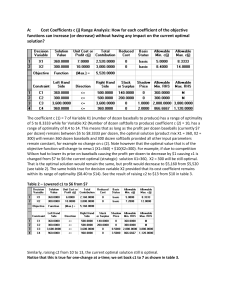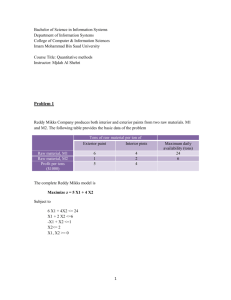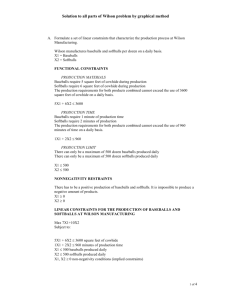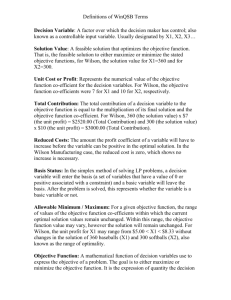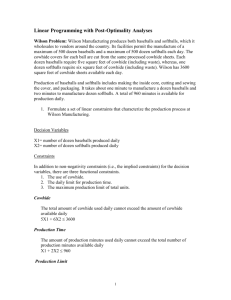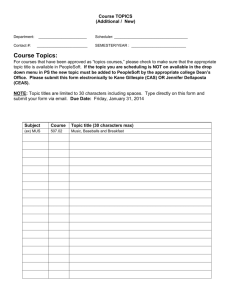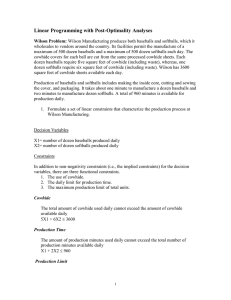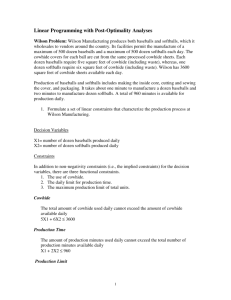Here (Word)
advertisement
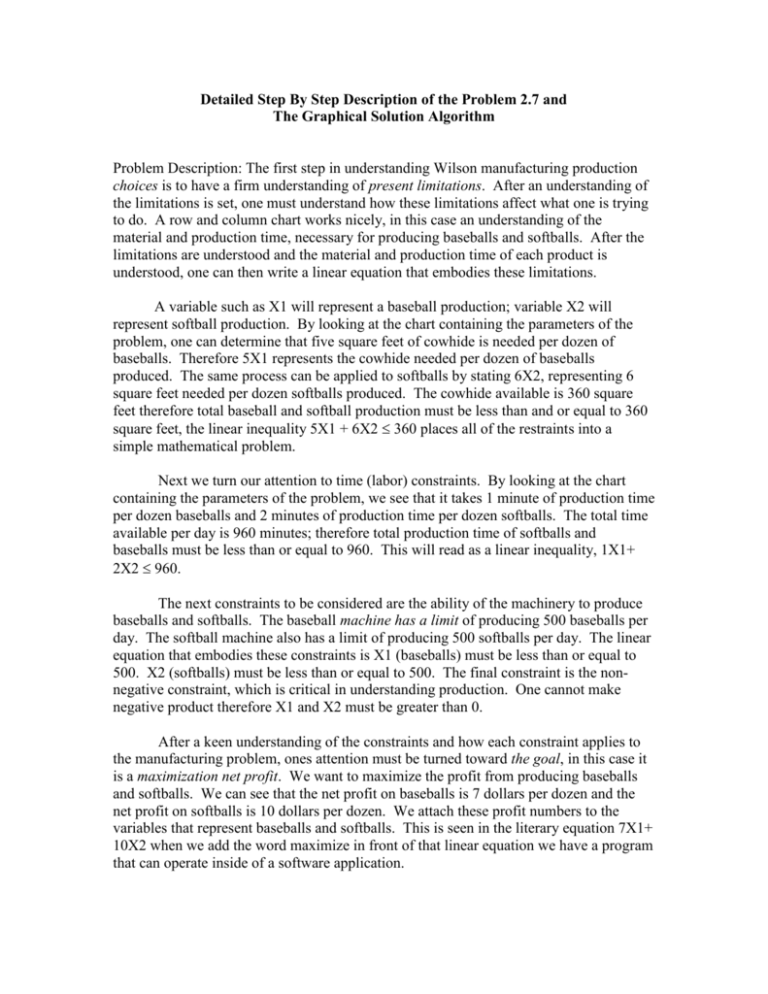
Detailed Step By Step Description of the Problem 2.7 and The Graphical Solution Algorithm Problem Description: The first step in understanding Wilson manufacturing production choices is to have a firm understanding of present limitations. After an understanding of the limitations is set, one must understand how these limitations affect what one is trying to do. A row and column chart works nicely, in this case an understanding of the material and production time, necessary for producing baseballs and softballs. After the limitations are understood and the material and production time of each product is understood, one can then write a linear equation that embodies these limitations. A variable such as X1 will represent a baseball production; variable X2 will represent softball production. By looking at the chart containing the parameters of the problem, one can determine that five square feet of cowhide is needed per dozen of baseballs. Therefore 5X1 represents the cowhide needed per dozen of baseballs produced. The same process can be applied to softballs by stating 6X2, representing 6 square feet needed per dozen softballs produced. The cowhide available is 360 square feet therefore total baseball and softball production must be less than and or equal to 360 square feet, the linear inequality 5X1 + 6X2 360 places all of the restraints into a simple mathematical problem. Next we turn our attention to time (labor) constraints. By looking at the chart containing the parameters of the problem, we see that it takes 1 minute of production time per dozen baseballs and 2 minutes of production time per dozen softballs. The total time available per day is 960 minutes; therefore total production time of softballs and baseballs must be less than or equal to 960. This will read as a linear inequality, 1X1+ 2X2 960. The next constraints to be considered are the ability of the machinery to produce baseballs and softballs. The baseball machine has a limit of producing 500 baseballs per day. The softball machine also has a limit of producing 500 softballs per day. The linear equation that embodies these constraints is X1 (baseballs) must be less than or equal to 500. X2 (softballs) must be less than or equal to 500. The final constraint is the nonnegative constraint, which is critical in understanding production. One cannot make negative product therefore X1 and X2 must be greater than 0. After a keen understanding of the constraints and how each constraint applies to the manufacturing problem, ones attention must be turned toward the goal, in this case it is a maximization net profit. We want to maximize the profit from producing baseballs and softballs. We can see that the net profit on baseballs is 7 dollars per dozen and the net profit on softballs is 10 dollars per dozen. We attach these profit numbers to the variables that represent baseballs and softballs. This is seen in the literary equation 7X1+ 10X2 when we add the word maximize in front of that linear equation we have a program that can operate inside of a software application. Next we turn our attention to making a graph (i.e., the feasible region) of the production problem. The horizontal axis represents baseballs and the vertical axis represents softballs. A vertical line should be drawn that bisects the 500 number mark on the X-axis; this line represents the maximum number of baseballs that can be produced. The horizontal line should be drawn that bisects the 500 mark on the Y-axis this represents the maximum number of softballs that can be produced. Next we graph the time constraint which is determined by drawing a point on the X-axis that represent the case that all the time were spent just making baseballs. Total time available is 960 so the point is at point 960. The Y-axis, which represents the time necessary to make softballs, the point would be at 480. When a line is then drawn across the graph plain, this line will represent the time constraint. Finally we have to draw the cowhide restraint. This is determined by finding the point in the X-axis that represents the case if all the cowhide were used on baseballs. This point is 720. Now we draw a line on the Y-axis that represents, if all of the cowhide were used on softballs. This number is 600 we connect those two dots with a line to the graph plain. Because the cowhide restraint must be less than 3600, all the area to the right of the cowhide constraint line will not be included in the solution. Because the time constraint is equal to or less than 960 all the area above the time constraint line will not be included in the solution. Because the limit of 500 placed on baseballs all the area to the right of the baseball constraint line will not be included in the solution. Because the constraint of 500 is placed on softballs, all the area above the softball constraint line is excluded from the solution. When all of these lines are placed on a graph and the areas that are excluded are removed, including the negative areas, the area that is left is called the feasible region. Any point inside or on the boundary lines of the feasible region can be accomplished under present constraints. In order to maximize profits, a point where two of the line constraints bisect must be chosen. There are four such points in our problems. After subtracting linear equation from linear equation the best point of manufacturing is where the cowhide constraint and the time constraint bisect, this point would be producing 360 baseballs and 300 softballs. As we know, a Formulation of the Wilson Manufacturing problem is: X1 = the number of dozen baseballs manufactured daily X2 = the number of dozen softballs manufactured daily. Max Objective Function 7X1+10X2 Subject to: C1 = X1 500 C2 = X2 500 C3 = 5X1 + 6X2 3600 C4 = X1 + 2X2 960 C5 = Xj 0; j = 1, 2 (constraint of production) (constraint of production) (this is the constraint of the material) (the constraint of the production time available) (non negativity) a. Graph the feasible region for this problem (Hand computation is submitted separately). C4 relegates the solution to quadrant I. X1 and X2 must be positive numbers (or 0). Wilson is considering manufacturing 300 dozen baseballs and 300 dozen softballs. Applying the constraints: C1; X1 < 500; 300 < 500. Constraint is satisfied. C2: X2 < 500; 300 < 500. Constraint is satisfied. C3; 5X1 + 6X2 < 3600; 5(300) + 6(300) =3300<3600. Constraint is satisfied. C4; X1 + 2X2 < 960; 300 +2(300) = 900 < 960. Constraint is satisfied. Since the constraints are satisfied, the solution of 300 dozen each is an interior point located within the feasible area. Wilson considers manufacturing 350 dozen baseballs and 350 dozen softballs. Again, applying the constraints: C1; X1 500; 350 < 500. C2; X2 500; 350 < 500. C3; 5X1 + 6X2 3600; 5(350) +6(350) = 3850 > 3600. C4; X1 + 2X2 960; 350 + 2(350) = 1050 > 960. Constraint is satisfied. Constraint is satisfied. Constraint is not satisfied. Constraint is not satisfied. Wilson does not have enough materials or the time necessary to manufacture according to this strategy. Constraints C3 and C4 are infeasible points. Neither point is an optimal solution. This is because one of these strategy corresponds to an interior point of the feasible region, we know any interior can never be an optimal solution. Because it is an interior point there is always some extra between the point and the binding constraint (called slack in maximization problem or surplus in a minimization) that prohibits the optimal solution until it has been removed. The second strategy corresponds to a point which is outside of the feasibility region and therefore is not feasible (i.e. possible) under the constraints imposed. b. Wilson estimates that its profit is $7.00 per dozen baseballs and $10.00 per dozen softballs, the production schedule that maximizes their daily profit is found at the extreme point, (360, 300). 7(360) + 10(300) = 5,520. c. C1; X1 500 is a non-binding constraint C2: X2 500 does not eliminate any points from consideration. It is redundant. C3; 5X1 + 6X2 3600 is a binding constraint. C4; X1 +2X2 960 is a binding constraint. C5; Xj 0 j = 1, 2, is a non-binding.
